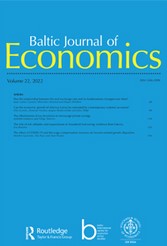Can the economic growth of interwar Latvia be estimated by contemporary national accounts?
Can the economic growth of interwar Latvia be estimated by contemporary national accounts?
Author(s): Ola Honningdal Grytten, Zenonas Norkus, Jurgita Markevičiūtė, Jānis ŠiliņšSubject(s): National Economy, Economic history, Economic policy, Economic development, Interwar Period (1920 - 1939)
Published by: BICEPS/SSE Riga
Keywords: National accounting; national income; economic growth of interwar Latvia; Alfreds Ceichners;
Summary/Abstract: The paper provides an examination of interwar Latvia’s national accounts, checking their usability for estimating interwar economic growth performance. According to the authoritative account of Roses and Wolf [(2010). Aggregate growth, 1913–1950. In S. Broadberry, & K. H. O’Rourke (Eds.), The Cambridge economic history of modern Europe, vol 2. 1870 to the present (pp. 183– 207). Cambridge UP.], based on indirect estimation methods, Latvia’s GDPpc growth rate from 1929 to 1938 was the highest in Europe. However, according to Aizsilnieks [(1968). Latvijas saimniecības vēsture, 1914–1945. Daugava.] interwar national income estimates show that the Latvian economy stagnated in the 1930s. This paper’s main findings are that applying historical price indices to the existing interwar output estimates supports the stagnation thesis. However, the national income estimates lack validity and reliability due to unpersistent or unknown methodology. Hence, changes in real output cannot be established without new calculations according to the contemporary System of National Accounts (SNA 2008) framework.
Journal: Baltic Journal of Economics
- Issue Year: 22/2022
- Issue No: 2
- Page Range: 90-109
- Page Count: 20
- Language: English

